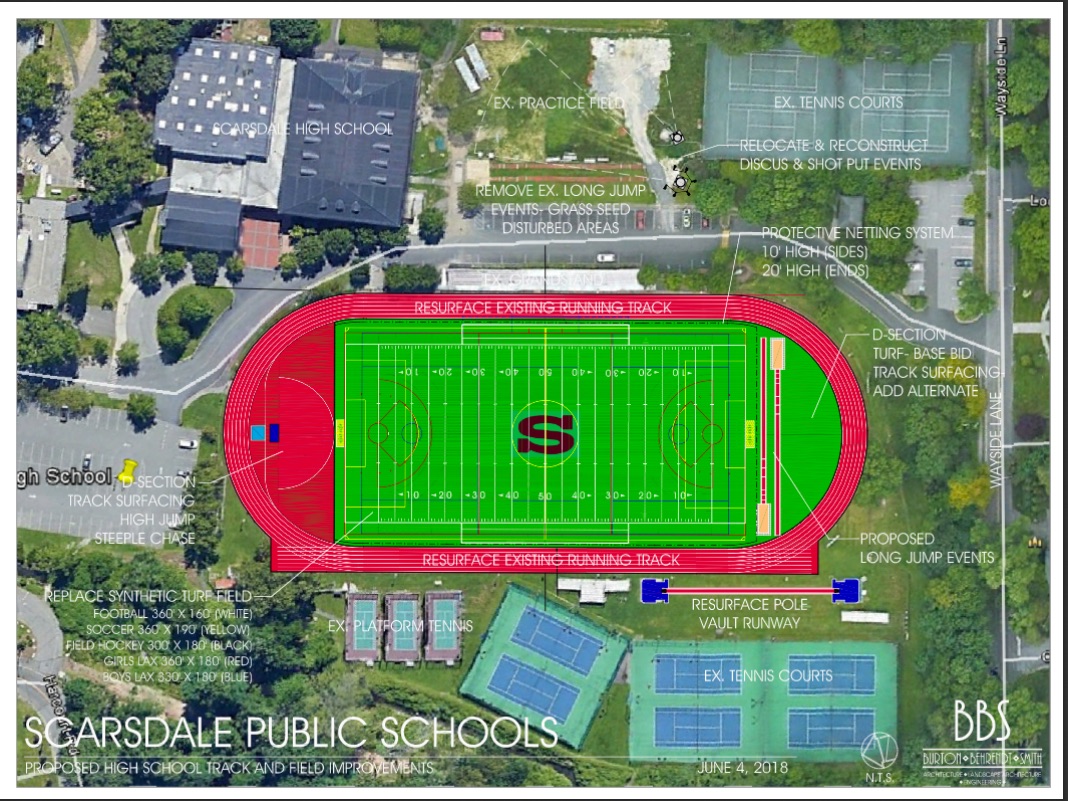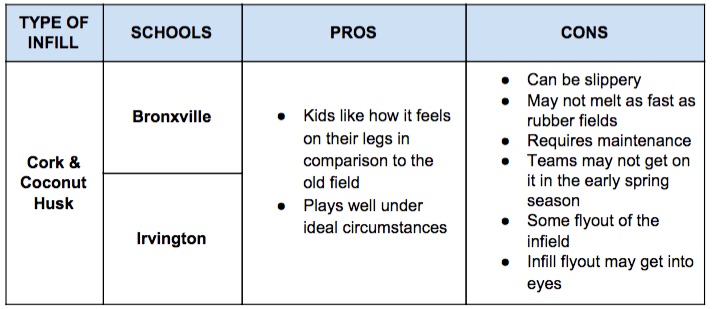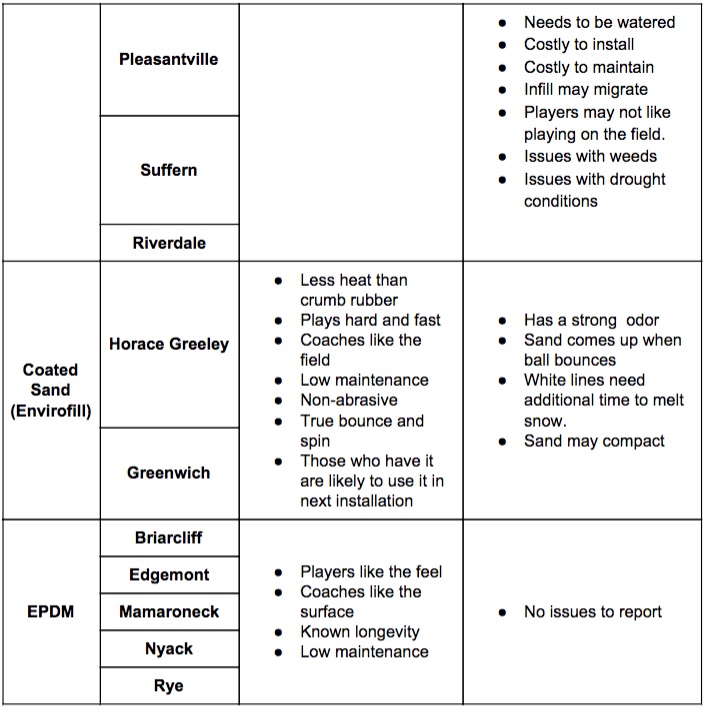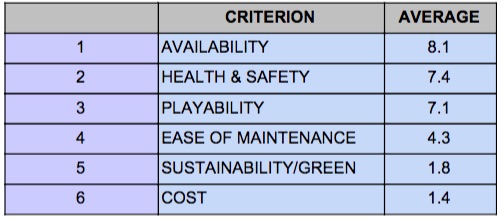Committee Recommends Using EPDM Infill for Replacement of Synthetic Turf at Butler Field
- Category: Schools
- Published: Wednesday, 13 June 2018 13:41
- Joanne Wallenstein
 The Butler Field Committee comprised of administrators, coaches, parents and students was convened to analyze options for replacement of the 13 year-old turf field at SHS and to make a recommendation to the Board. At the June 11 meeting of the Scarsdale BOE, Athletic Director Ray Pappalardi reviewed the committee’s report and explained why they had decided on a synthetic turf with Ethylene Propylene Diene Monomer (EPDM) black rubber infill as well as renovations to the track and relocation of some of the track and field events to another area.
The Butler Field Committee comprised of administrators, coaches, parents and students was convened to analyze options for replacement of the 13 year-old turf field at SHS and to make a recommendation to the Board. At the June 11 meeting of the Scarsdale BOE, Athletic Director Ray Pappalardi reviewed the committee’s report and explained why they had decided on a synthetic turf with Ethylene Propylene Diene Monomer (EPDM) black rubber infill as well as renovations to the track and relocation of some of the track and field events to another area.
The committee based their decision on the following criteria:
Availability
How early is the field available in the Spring?
Can you get on the field during the hottest days typically in August?
Is the field available after a medium or heavy rain?
Are there days lost due to maintenance?
Health and Safety
What are the current or known health risks?
What are the future or unknown health risks?
What are the concussion impact or injury risks?
Playability
Infill splash-bounce displacement
Ball speed and running speed
Similarity to grass for softness
Ease of Maintenance
Additional man-hours required on a regular basis?
Equipment or storage requirements?
Frequency of replacing lost infill
Sustainability
Made from recycled or renewable material?
Organic?
Disposal method at end of useful life?
Source country of materials?
Cost
Annual operational costs
Upfront cost
Expense of replacing lost infill
The committee visited numerous sites to learn more about different varieties of infill and spoke to parents, coaches and administrators in other districts about their experience with different surfaces.
Based on their research, they came up with the following:


At their May 24 meeting, they weighed the criteria to determine their ranking of priorities and came up with this analysis:

They concluded that fields with rubber infill are more readily available than those with organic infill such as cork or coconut husks. Fields with coated sand infill also have good availability and drain well.
For health and safety, they found that fields with EPDM and coated sand infill allow for the use of turf shoes rather than cleats, which increase traction and are a contributing factor to injuries of the lower extremeties. They learned that the fields with organic infill are slippery when wet and may be less safe.
In terms of playability, under ideal conditions, the organic infill feels good to the players. However when it’s dry, the flyout gets into players eyes and mouths. Coated sand feels hard and plays fast. The committee found that EPDM plays well and provides a consistent surface for play in most weather.
Organic fields require more maintenance as they require grooming after rain as well as weeding. However, organic infills are the most sustainable option as they are compostable whereas EPDM and coated sand must be taken to a landfill.
The committee estimated that the annual operating costs for the organic field would be $36,000 as compared to $5,000 for the EPDM.
Based on their work, they recommended that the district install EPDM black rubber infill with a shock pad between the base layer and the synthetic turf, for both safety and playability.
They recommended that the six-lane track as well as the high jump, long jump and pole vault be replaced.
They also recommended that the aging goal posts be replaced and that field safety netting be installed around the field to prevent lacrosse and soccer balls from flying on the track.
The plan calls for turf work to begin in November 2018 and track work to begin in June 2019.
The budget for this work, including drainage improvements would be $1.712 mm. If the district decides to go with green EPDM rather than black, it would cost an additional $256,800and bring the cost to $19.5mm.
The committee also recommended additional work to the track, totaling another $250,000. The Board will need to decide whether or not to do this work at the same time as the turf replacement project.
In the discussion, Board Member Nina Cannon questioned the use of black vs. green infill and was told that the black is less expensive because it is more readily available, though the green might be cooler on hot days.
Art Rublin asked about sustainability, and Andrew Patrick replied, saying that the committee acknowledged that playability, not sustainability, was the objective of the project. Rublin also asked if there were any health studies available about the safety of EPDM and Stuart Mattey responded that the committee was not aware of any studies.
Lee Maude questioned whether or not the additional $250,000 should be spent on the track and field improvements. Chris Morin said, “We should decide if these are worthwhile and if so, use the most efficient way to make these improvements.”
The Board of Education will vote on the field replacement at their next meeting on Tuesday June 10, 2018.
Also discussed at the meeting were gifts to the district, a new social media policy and a revision to the Code of Ethics of District Officers and Employees.
Annual Gift Review
The Board conducted an annual gift review of all gifts given to the seven district schools. They have received a total of $128,345.86 in gifts over the 2017-18 school year from various organizations, including the seven school’s PTA organizations. One of the more recent gifts was $15,000 from the Fox Meadow PTA for new smart furniture, which includes standing desks, kinesthetic seating, and communal tables to create a more innovative and modular learning environment for Fox Meadow students. Board Member Leia Maude questioned the role the district would play in “owning up” to the purchase of the furniture, to which Dr. Hagerman responded that there is an expectation that once the school accepts the gift, the district will need to decide to either maintain it or eventually get rid of it. Hagerman also noted that Edgewood has also experimented with this kind of furniture and other schools will likely install more smart furniture in the future.
This discussion also led board member Art Rublin to discuss the issue of disparity, and maintaining equality among the elementary schools. Dr. Hagerman noted that the five schools should have a general shared experience, but are each unique. He thought it was best to look at the issue of equality by not necessarily looking at the amount of gifts a school receives in one year, but rather over multiple years. The Greenacres PTA, for example, has been holding out on spending a significant amount of money on gifts due to upcoming construction. Board President William Natbony agreed that it is key to ensure that these disparities do not exist in the long term and that all elementary students receive a high quality but unique experience.
Social Media Policy
Also discussed was the first reading of a new Social Media Policy presented by Director of District Technology Jerry Crisci. The new policy can be reviewed here:
The policy includes guidelines and education for students and staff on the use of social media. Board President William Natbony, questioned some of the phraseology used in the policy which states, “Under no circumstance should inappropriate comments be made about any member of the school community. Any user who receives threatening or unwelcome communications or material should report them to a teacher, a school administrator or the Director of Technology” but it did not define the terms “inappropriate” and “unwelcome.” Natbony asked, “If a student made a constructive comment online that criticized their teacher, for example, would that be worthy of punishment? Natbony believes the words “disrespectful” and “offensive” might be better suited. Additionally, the policy states that “Engaging in social-networking non-academic friendships with current Scarsdale students is discouraged”, but board members expressed some concern as students often seek help from teachers on personal issues, and this line could potentially alienate those students. Board Member Art Rublin suggested gathering community input on this policy before implementation.
Code of Ethics
The Board also reviewed revisions to the Code of Ethics for school district officers and employees. They discussed the section regarding school gifts that now says, “A Board member, officer or employee shall not directly or indirectly solicit any gift or accept or receive any gift having a value of $15 or more ,… under circumstances in which it could reasonably be inferred that the gift was intended to influence him or her in the performance of his or her official duties or was intended as a reward for any official action on his or her part”. Assistant Superintendent Drew Patrick recommended that the $15 limit be scrapped, as no gifts of any monetary amount should be able to influence the intentions of any staff or board member of the Scarsdale Schools.
Board Member Nina Cannon brought up the future employment provision, which states that "A Board member, officer or employee shall not, after the termination of service or employment with the district, appear before the Board/District in relation to any action, proceeding, or application in which he or she personally participated during the period of his or her service or employment or that was under his or her active consideration while he/she was with the District.” For example, this clause would prohibit retiring Board Member Art Rublin from speaking at a future meeting on an issue covered at a meeting in which he was a board member.







